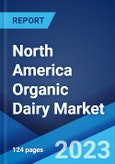Organic dairy products are manufactured using organic milk, which is obtained from livestock raised through organic farming methods. These products are considered healthier as compared to the conventional dairy products as these are rich in omega-3 fatty acids, vitamins, antioxidants and conjugated linoleic acid (CLA). These dairy products are also free from preservatives, antibiotics, synthetic chemicals, etc. Apart from this, they offer myriad health benefits to consumers, such as strengthening immune system, boosting metabolism, reducing muscle and joint pain, and lowering the risk of cancer and heart diseases.
North America organic dairy market is currently being driven by several factors. Consumers in the region are switching to organically produced dairy products owing to the rising health consciousness among them. Furthermore, the increasing awareness about the health benefits of these products has also catalyzed their demand in the region. Apart from this, the improved retail channels across the region have induced the easy availability of organic dairy products in hypermarkets, supermarkets, convenience and grocery stores, etc. Additionally, there are different types of organic dairy products available in the market that are offering a vast product portfolio to the consumers. This includes products, such as milk, yoghurt, flavored milk, ice cream and cheese, which can cater to the taste and preferences of a large number of consumers.
The publisher's latest report provides a deep insight into the North America organic dairy market covering all its essential aspects. This ranges from macro overview of the market to micro details of the industry performance, recent trends, key market drivers and challenges, SWOT analysis, Porter’s five forces analysis, value chain analysis, etc. This report is a must-read for industry players, investors, researchers, consultants, business strategists, and all those who have any kind of stake or are planning to foray into the North America organic dairy market in any manner.
Key Market Segmentation:
The publisher provides an analysis of the key trends in each sub-segment of the North America organic dairy market report, along with forecasts at the regional and country level from 2023-2028. The report has categorized the market based on product type, packaging type and distribution channel.Key Regions Analysed
- United States
- Canada
- Analysis for Each Country
Market by Product Type
- Organic Fluid Milk
- Organic Yogurt
- Organic Cheese
- Organic Butter
- Organic Cream
- Others
Market by Packaging Type
- Pouches
- Tetra-Packs
- Bottles
- Cans
- Others
Market by Distribution Channel
- Supermarkets and Hypermarkets
- Discount Stores
- Convenience and Grocery Stores
- Organic Specialty Stores
- Online Stores
- Direct Sales
- Others
Value Chain Analysis
- Key Drivers and Challenges
- Porters Five Forces Analysis
- Competitive Landscape
- Competitive Structure
- Key Player Profiles
Key Questions Answered in This Report
1. What was the size of the North America organic dairy market in 2022?2. What is the expected growth rate of the North America organic dairy market during 2023-2028?
3. What are the key factors driving the North America organic dairy market?
4. What has been the impact of COVID-19 on the North America organic dairy market?
5. What is the breakup of the North America organic dairy market based on the product type?
6. What is the breakup of the North America organic dairy market based on the packaging type?
7. What is the breakup of the North America organic dairy market based on the distribution channel?
8. What are the key regions in the North America organic dairy market?
Table of Contents
Methodology

LOADING...
Table Information
| Report Attribute | Details |
|---|---|
| No. of Pages | 124 |
| Published | September 2023 |
| Forecast Period | 2022 - 2028 |
| Estimated Market Value ( USD | $ 9.7 Billion |
| Forecasted Market Value ( USD | $ 14 Billion |
| Compound Annual Growth Rate | 6.3% |
| Regions Covered | North America |









